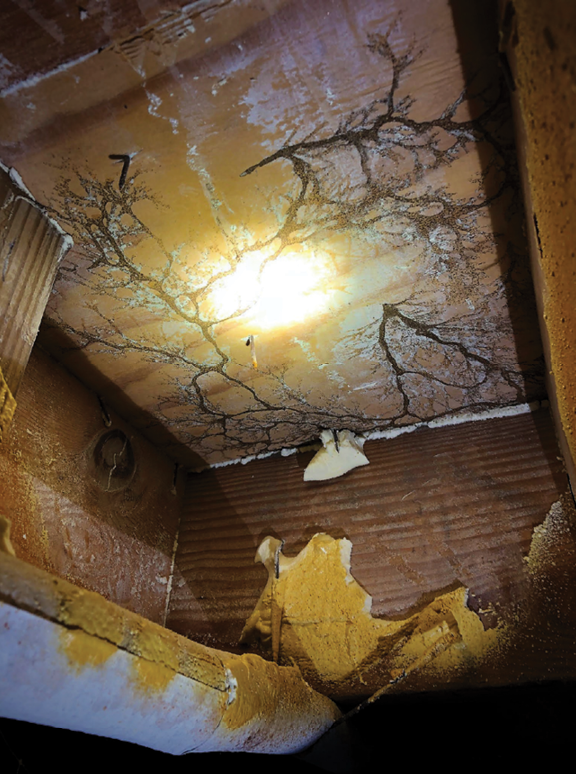
On the morning of Oct. 10, 2018, Amanda Kaiser already had called three customers to cancel their termite warranties. “We are cancelling customers monthly. It’s become a really big deal,” said the owner of Island Pest Control, Hilton Head Island, S.C.
The big deal is spray polyurethane foam (SPF) insulation, which can significantly improve a home’s energy efficiency when installed in crawlspaces, walls and attics. PMPs are finding it also can hide termite activity.
WHAT IS SPF? Spray polyurethane foam insulation is a spray-applied cellular plastic. When applied, the chemicals react quickly, expanding on contact to create a foam that insulates, seals air gaps and provides a moisture barrier. When properly installed, SPF forms a continuous barrier on surfaces. It resists heat transfer and is an effective solution for reducing unwanted air infiltration through cracks, seams and joints.

SPF insulation can be open- or closed-cell. Open-cell spray foam contains microscopic voids that are open to each other. It is soft and flexible and has a higher moisture permeability. In closed-cell foam, the microscopic voids are isolated from one another. This foam is rigid, dense, resistant to water, has a higher R-value, and can improve a building’s strength (a key benefit in high-wind and hurricane-prone areas).
The type of foam used and the thickness in which it’s applied depends on the problem being addressed and where in the structure it’s being used.
At one client’s home with SPF, Kaiser said pests had “eaten across half the house” before they swarmed and were found. At another, her inspector noticed dirt specks on a piece of foam in the crawlspace. “He pulled it back and boom, there were termites behind it,” she recalled. And still another homeowner didn’t know his $2 million house had termites from subfloor to attic until he started adding on to it; her technicians pulled out the SPF and found “endless” amounts of termite damage.
PMPs report that the foam also hides leaks and traps moisture that homeowners normally would notice and fix. This creates conditions that attract termites and even can lead to aerial infestations of the pests.
“If termites find it, they’re going to use it to go all the way to the roofline,” said Tim Kendrick, technical director of Wayne’s Environmental Services, Birmingham, Ala., and president of the Alabama Pest Control Association. He pulled a 30-pound Formosan termite carton nest from the wall of a client’s spray-foamed attic. The pests damaged eight rooms in the slab house before they swarmed and were found.

“There’s just no way to see what’s behind that spray foam” and “we’re not going to roll the dice” in Formosan country, said Kaiser. “It’s just not worth the risk.”
A growing number of PMPs across the Southeast feel the same way. They are cancelling the termite damage warranties of customers who’ve had the foam installed. They are walking away from new customers who already have it in their homes and from newly constructed homes that have it built in. And some are refusing to write termite/WDO inspection letters required for real estate closings if houses have SPF. “We recognize that there’s an issue. It’s our strong position that we are not the origin of these problems but we’re involved in this,” said Kurt Riesenberg, executive director of the Spray Polyurethane Foam Alliance (SPFA), the trade association for spray foam installers.
SPRAY FOAM SURPRISE. PMPs generally don’t learn customers have installed spray foam insulation in their crawlspaces or attics until they return for an annual termite or wood-destroying organism (WDO) inspection.
What they find runs the gamut: Some foam applicators provide termite inspection and treatment gaps at the top and bottom of the crawlspace foundation wall; others encase the entire crawl in 6 to 8 inches of spray foam covering the walls, sill plates, outside band and subfloor, much like a cave.
“It’s the wild, wild West out there; there’s no consistency” in how the foam is applied from house to house, said Scott Monds, general manager of National Exterminating Company, Newport News, Va.
In most cases, the areas that PMPs need to inspect for termite mud tubes, such as the inside of the foundation wall or the sill plate where termites may come up through a hollow cinderblock, are now covered.
Spray foam insulation “can’t be removed for inspection like fiberglass batting. It is as hard as a rock and it sticks,” said Jim Fredericks, who heads technical and regulatory affairs for the National Pest Management Association.
And while some states have building codes for installing spray foam in new construction, fewer have codes for its application post-construction, report PMPs. These codes also vary greatly from municipality to municipality, which may adopt different parts or versions of codes.
“There’s mass confusion over what the right way to do it is,” says Wayne’s Environmental Services’ Kendrick.
Pesticide Program Chair Ryan Okey of the Department of Pesticide Regulation at Clemson University said “there needs to be some standards introduced for installation” of the foam to protect consumers, though he admitted that enforcing these standards would be a challenge.
The Spray Polyurethane Foam Alliance supports changes to building codes that mandate inspection strips in the crawlspace in jurisdictions with termite pressure, said Riesenberg. “We have to rely upon the code communities to make the proper determination of what’s required, and then our job is to make sure our installers know what’s required and that they do it,” he said.

GAP OR NO GAP? In the meantime, how pest control companies respond to spray foam varies greatly. While some won’t touch a house with it, others will keep customers under warranty if the foam applicator installs inspection gaps or comes back to cut them out.
“It’s not always where we see termites but it’s a good place to start,” said Stephen Gates, vice president of technical services at Cook’s Pest Control in Decatur, Ala.
But according to Art Appel, an entomologist at Auburn University who is conducting studies on closed-cell spray foam insulation, “we have no data that shows a 6-inch gap is sufficient to provide that adequate inspection. We kind of think it is. But what if it’s not?”
National Exterminating’s Monds said an inspection strip “can give folks false hope.” You have no idea if termites are active behind the spray foam on a foundation wall, and the pests have 12 months until the next annual inspection to potentially bridge that gap, he explained.
Johnny Baker doesn’t like inspection gaps, either. “I still think you’re going to have a lot of places where that’s not going to work,” especially in areas of high humidity where moisture gets trapped between the SPF and the wood and makes a “perfect haven” for the termites, said the owner of Columbus, Mississippi-based Baker Insurance, which insures pest control companies.
Some PMPs only feel confident when a spray-foamed crawlspace has gaps for inspection and treatment at both the top and bottom of the foundation wall. Others, like Island Pest Control, will work with customers who contact them before foam is applied so they can first treat the crawlspace wood with borate. “We don’t like to do that, but we will,” said Kaiser.
Individual pest control companies “have to figure out the best way forward,” and that’s difficult because as an industry “we’re still uncovering potential scenarios that will impact new best practices for providing service to customers,” said Chris Gorecki, vice president of operational support at Rollins Inc.

A new concern about spray foam recently surfaced: How to properly fumigate attics that have it. Another is how to retreat houses with liquid termiticide when parts of the crawlspace are inaccessible.
The spray foam issue has “10,000 tentacles.” “It just keeps morphing and getting bigger” and that makes it a challenge to provide guidance to employees and customers, Gorecki said.
MAKING NOISE. Customers get angry when you tell them you can no longer honor their termite warranty after they’ve just spent thousands of dollars to install the insulation, said Ryan Yoakum, general manager of ALL Exterminating in Cumming, Ga. He’s had the difficult conversation with 50 customers in the past two years.
To get ahead of this, PMPs are reaching out to customers to educate them on the challenges that SPF poses to termite protection and to encourage them to call their termite company before they have it installed. They’re mailing letters and postcards, doing email blasts, running ads in local newspapers, even sticker-ing up service vehicles.
Some pest management companies, however, are using false or inaccurate information in their advertising to scare consumers away from spray foam, such as citing lawsuits that cannot be verified, said Riesenberg. “There’s a real guerilla- warfare type of approach that we feel that the pest management industry has engaged in that’s only getting worse,” he said.
In November, Fox5 News in Atlanta ran a series of investigative reports on spray foam. Rick Bell, who heads government affairs and industry stewardship at Arrow Exterminators, Atlanta, expected the reports to cause “a lot of consternation” with homeowners.

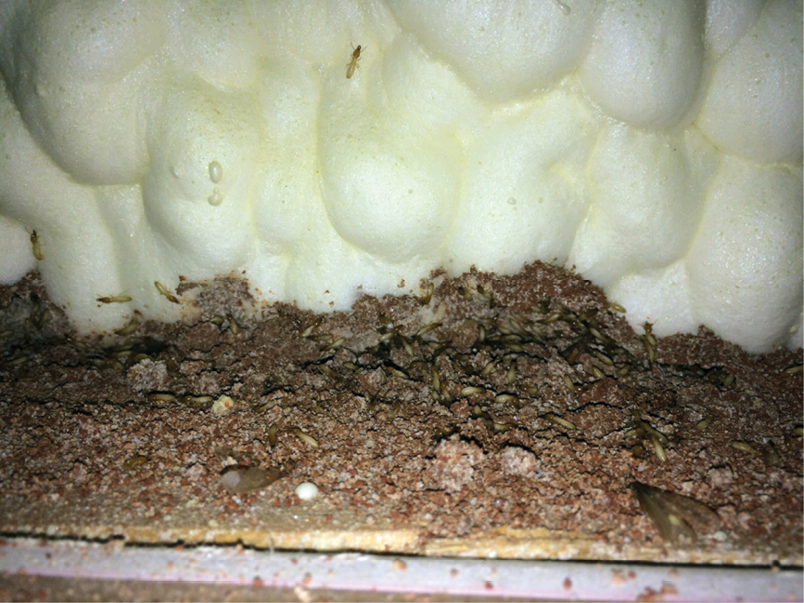
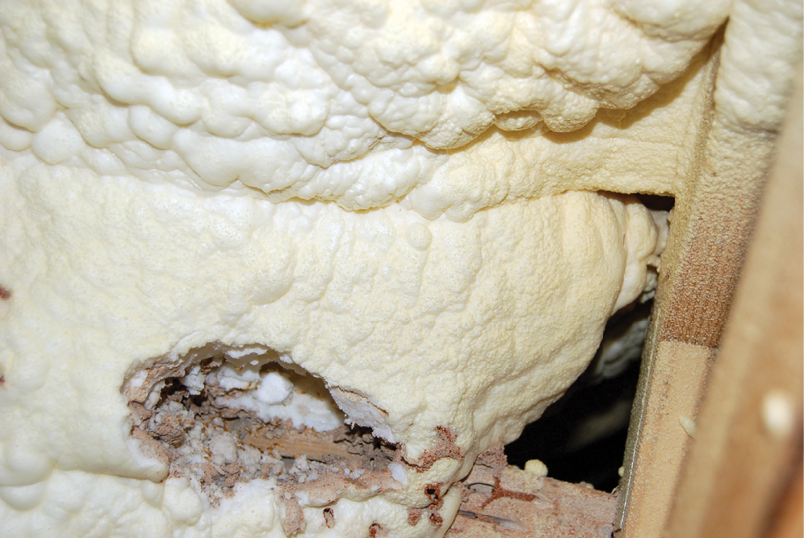
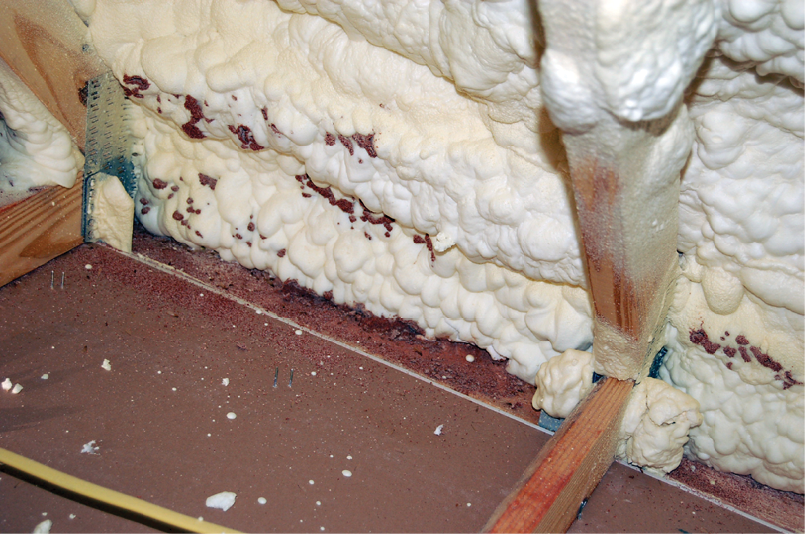
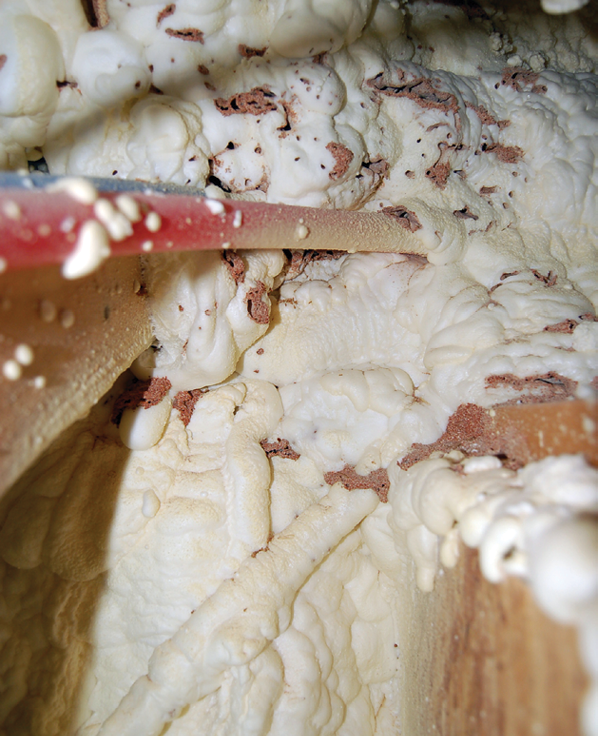
SEEKING SOLUTIONS. In January, NPMA met with SPFA, the Spray Foam Coalition (representing foam manufacturers) and other stakeholders at the Georgia Pest Control Association conference.
Both sides came away with a better understanding of how the other industry operates, as well as the challenges each faces in protecting the consumer. “Both sides listened. I felt like it was very constructive when it was all over with,” said Arrow’s Bell, who attended the meeting. He said the group discussed developing code amendments that would allow for termite inspection gaps where the foundation wall meets both the sill plate and the ground. “I’m optimistic that we’re going to continue to move forward and get something done,” said Bell.
The issue requires “our respective industries to be working proactively and positively with each other,” said Riesenberg, SPFA.
A meeting in mid-January between NPMA, Douglas Products and BASF’s construction materials division, one of many spray foam manufacturers, likewise was productive, NPMA said in a newsletter.
In other recent moves, NPMA’s WDO Committee was considering changes to the wood-destroying insect report form (NPMA-33) to list spray foam insulation as a specific obstruction to inspection.
The Georgia Department of Agriculture issued a consumer alert about spray foam and termite protection in September. PMPs in other states were encouraging departments of agriculture to distribute similar alerts.
Pest control companies are meeting with local building code officials, spray foam applicators and new home builders. Builders see the value of the spray foam but they also see the value of a termite warranty when they’re selling a home, explained Rollins’ Gorecki. “The good news is we have good relationships with a lot of those builders” and “now they’re asking questions. They didn’t always think about this” issue previously, he said.
Spray foam insulation isn’t a big deal for Gregory Pest Solutions in Greenville, S.C. The company occasionally finds it in crawlspaces and will ask customers to cut it back to provide a termite inspection window. “It hasn’t disrupted business. It’s not really creating issues for us,” said Larry Motes, director of operations.
Others said issues with spray foam insulation will increase and could leave many homeowners without termite protection. After you void their warranty, what other reputable company is going to pick them up, asked National Exterminating Company’s Monds.
“There’s nothing wrong with our product,” said Riesenberg of spray foam insulation, which has been vetted and tested for 50+ years. “Our product is legal; it’s recognized in the code; it performs the way it’s supposed to. If the pest industry needs to figure out new ways to accommodate modern construction technology then they need to get to work on that, do some research, work on the code and make sure that they have inspection strips in every state in the three-quarters of the U.S. that have termite activity on the map,” he said.This is a developing story. Stay tuned to PCTonline.com for updates.
The author is a frequent contributor to PCT.
Is Spray Foam Insulation the Next EIFS?
PMPs are cautious about spray foam insulation because of what happened in the late-1990s. That’s when many held termite warranties on houses built with exterior insulation and finish systems (EIFS), such as Dryvit. The artificial stucco trapped moisture and termites tunneled undetected through the systems’ foam board insulation, often installed below grade. Pest control companies paid out millions in insurance claims to cover termite damage. Some lost their insurance as a result.
“EIFS was on the exterior and prevented us from determining if an infestation was present. Spray foam is on the interior and it prevents us from determining if an infestation is present. They both hold water. They’re both next to the food source” of termites, said Rick Bell, who heads government affairs and industry stewardship at Arrow Exterminators in Atlanta.
Energy Savings Drive SPF Growth
More customers are having SPF insulation installed in their homes to increase energy efficiency, improve comfort and save money on energy bills.
In 2017, it was installed in some part of roughly 924,000 existing homes; about 120,000 newly constructed homes had it built in, according to an analysis of reports compiled by Home Innovation Research Labs, a subsidiary of the National Association of Home Builders.
The bulk of homes that have spray foam insulation are located in the Southeast, as well as Louisiana, Texas, Arizona and California, the organization stated on its website.
According to Lucintel, a Dallas-based market research company, the North American spray foam insulation market was estimated at $717 million in 2017 and it is expected to grow to more than $1 billion in 2023. Residential will remain the largest end-use and have the highest growth through 2023.
More Than Just Termites
Eastern subterranean and Formosan termites aren’t the only pests hard to detect with spray foam insulation, stated PMPs. Wood-decaying fungi, wood-boring beetles, powderpost beetles, carpenter ants, yellowjackets and honey bees also can reside in or behind it, said Ryan Yoakum, general manager of ALL Exterminating in Cumming, Ga.
Mice have been a problem for Emilio Polce, owner of EcoChoice Termite & Pest Control in Vernon, Conn. “I can’t tell you how many houses that I’ve gone to where they’ve over-sprayed and now mice are burrowing and nesting behind the spray foam and it’s become impossible to find out where the nest is,” he said.
Has the Industry Kept Pace With Building Science?

The International Building Code for spray foam insulation changed 11 years ago, said Kurt Riesenberg, executive director of the Spray Polyurethane Foam Alliance. “The pest management industry has been absent from a lot of the building science and building construction technology discussions, code discussions and everything else,” he said. Now with modern building practices the norm, PMPs “need to step up and they need to figure out how to make their product still work, make their inspections still work, their treatments still work in the environment that they’re given, just like we did. To just throw your hands up and say, ‘no’ — it’s not serving anybody but it’s sure not serving the customer,” said Riesenberg.

Auburn University Studies Spray Foam
Entomologist Art Appel, Auburn University, began studying closed-cell spray foam insulation in August. Early findings indicate that eastern subterranean termites will tunnel through it but prefer to “go between the back of the foam application and the front of the brick or the concrete,” where some separation in adhesion might occur, he said. He found carpenter ants and wood-boring beetles also will “attack and destroy” the foam.
Unfortunately, the foam does not have insecticidal properties and tunneling through it does not harm the insects. “To the best of our knowledge it does not kill anything,” he said.
In another experiment, Appel found the foam can get “water logged,” which “could be a problem because if it holds water and it’s warm then there’s a perfect place for something to nest.”
Cause to Cancel?

Cliff Slaten, founding partner of Slaten Law in Montgomery, Ala., does not recommend a PMP continue to warranty a house that cannot be inspected and treated properly. Generally, termite contracts allow firms to void warranties if a structure has been altered in a way that prevents inspections and treatments. For some clients, Slaten has written contract exclusions specific to spray foam insulation.
Those who continue to carry a warranty on such a home are on the hook for any termite damage that occurs. They also may be fined because most state regulations require a visual inspection of the structure and that’s not possible if key areas are covered by foam.
Cancelling contracts is “about the only way that we’re getting our point across” with customers and builders, said Butch Cauthen, Alabama district sales manager for Oldham Chemical. And while no one wants to lose a customer, he asked, “Do you want that $125 renewal or do you want to be sued for a million?”
Ryan Okey of the Department of Pesticide Regulation, Clemson University, urged PMPs to improve their inspections. “Don’t limit it to just the exterior or just the crawlspace,” he said. Look in the attic and identify changes to the entire structure that could impact termite control as soon as you can, he said.

News Alert: Don’t Fume Homes With SPF In Attics, Pending EPA Guidance
In September, Douglas Products and Ensystex sent letters advising fumigators to cease using Vikane and Zythor fumigants in homes with SPF in the attic pending further evaluation. The concern is that the fumigants used in these attics may need extended aeration times.
PMPs cannot modify how they aerate these spaces. “We are bound by the label which is federal law,” said Jim Fredericks, who heads technical and regulatory affairs for NPMA. The aeration times that are on that EPA-approved label are based on attics being ventilated; attics that are insulated with spray foam aren’t being ventilated, he said. Any changes to aeration must be evaluated, reviewed and approved by EPA, said Fredericks.
But other products beside spray foam are used to create unvented attics, cautioned Kurt Riesenberg, SPFA. “So your problem is not spray foam; your problem is an unvented attic that’s been recognized in the code for 11 years,” he said. Focusing only on spray foam could put homeowners with other types of unvented attics at risk, especially if a fumigator looks in an attic and assumes that a fumigation is good to go if he doesn’t see spray foam insulation.
“We don’t want our product to have a hand in any way in creating a life safety issue,” said Riesenberg.
Lawsuits Coming?

Homeowners angry over termite damage are holding pest management and spray foam companies responsible.
“We’ve had some claims and I think it’s going to get worse. I think we’re on the tip of the iceberg. The real claims are going to be ahead of us,” said Johnny Baker, owner of Baker Insurance. He advised PMPs who have a spray foam-insulated house under warranty to either drop it or make sure it’s on a retreat-only contract. “They should not have a repair contract on a house like this at all,” said Baker.
Carrying warranties on houses that can’t be properly inspected “leaves us wide open for the attorneys,” said Tim Kendrick, technical director, Wayne’s Environmental Services, Birmingham, Ala.
“It’s lawsuit city is what it is,” said ALL Exterminating’s Ryan Yoakum of the brewing problem. And “unfortunately in Georgia, pest control companies catch the punt for everyone else’s mistakes with a home,” he said.

Inspect A Better Way?
SPFA and the Spray Foam Coalition, which represents makers of foam and installation equipment, published a guidance document in October 2017 on spray foam insulation and termites. The report suggested that newer technologies be used to inspect for termites when SPF covers areas like sill plates, band/rim joists or the ends of the floor joists. This included using moisture meters, acoustic emission (listening) devices, microwave technologies, infrared cameras, air sampling (carbon dioxide and methane emissions) and specially trained dogs.
“We reviewed their document and did not endorse it,” said Jim Fredericks, NPMA. Infrared cameras can’t pick up thermal readings of termites in insulation — it insulates them — and dogs need air drafts to pick up the scent of termites but SPF eliminates these, he said.
“The most effective and widely used method of termite inspection, and in many cases is also mandated by regulation, is a visual inspection with sounding and probing,” Fredericks said.
Still, Kurt Riesenberg of SPFA was not aware of any scientific studies proving these advanced technologies do not work with spray foam. The building environment is evolving and PMPs can’t continue to rely on old construction technologies and inspection techniques, he said. “They need to enter the modern day and potentially use more advanced, more technically capable techniques to do their job,” said Riesenberg.
A Problem in Encapsulated Crawls? It Depends
A big difference exists between creating an encapsulated or conditioned crawlspace the right way and trying to achieve the same result by encasing the entire crawl from floor to subfloor in spray foam or rigid foam board insulation.
Unfortunately, many companies providing this service fall into the latter category, said PMPs. As such, some pest management companies are now offering encapsulation as an add-on service. Installations are designed to allow technicians to inspect for termite activity and may feature inspection and treatment gaps and the use of clear poly sheeting.
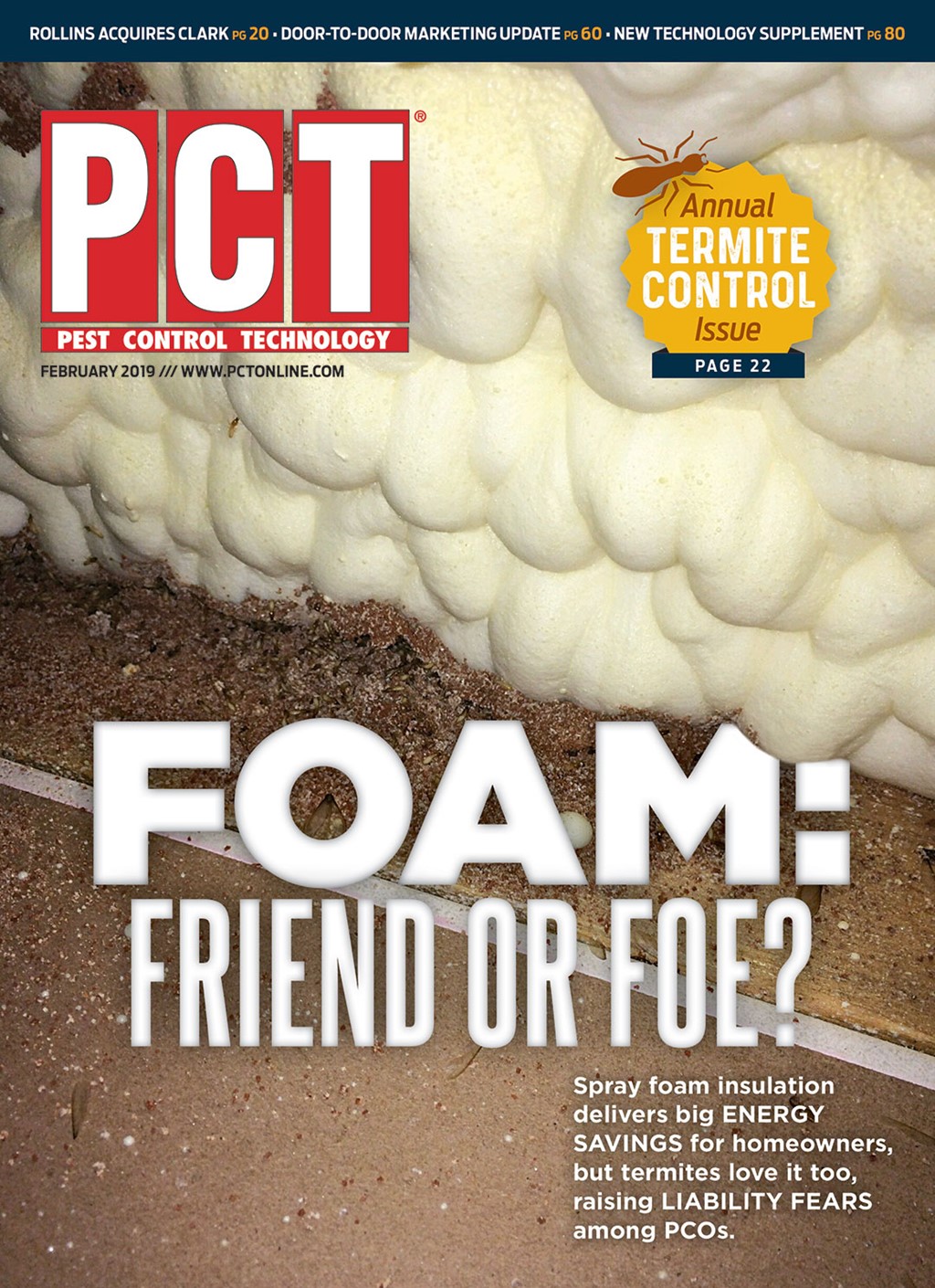
Explore the February 2019 Issue
Check out more from this issue and find your next story to read.
Latest from Pest Control Technology
- A Cautionary Tale of Honey Bees and Heat
- Mingle a Mile High in Denver
- PMP Helping Those in Need by Ensuring Secondhand Furniture is Free of Bed Bugs
- PPMA Unveils New Design of Mainframe Site
- UCR Entomologist Makes a Case for Eating Bugs
- Brown Recluse Spider Management: Correcting Contributing Conditions
- FMC Announces Donation to PestVets Give Back Program
- Liphatech Announces Refreshed Brand, Website and New Strategic Direction





